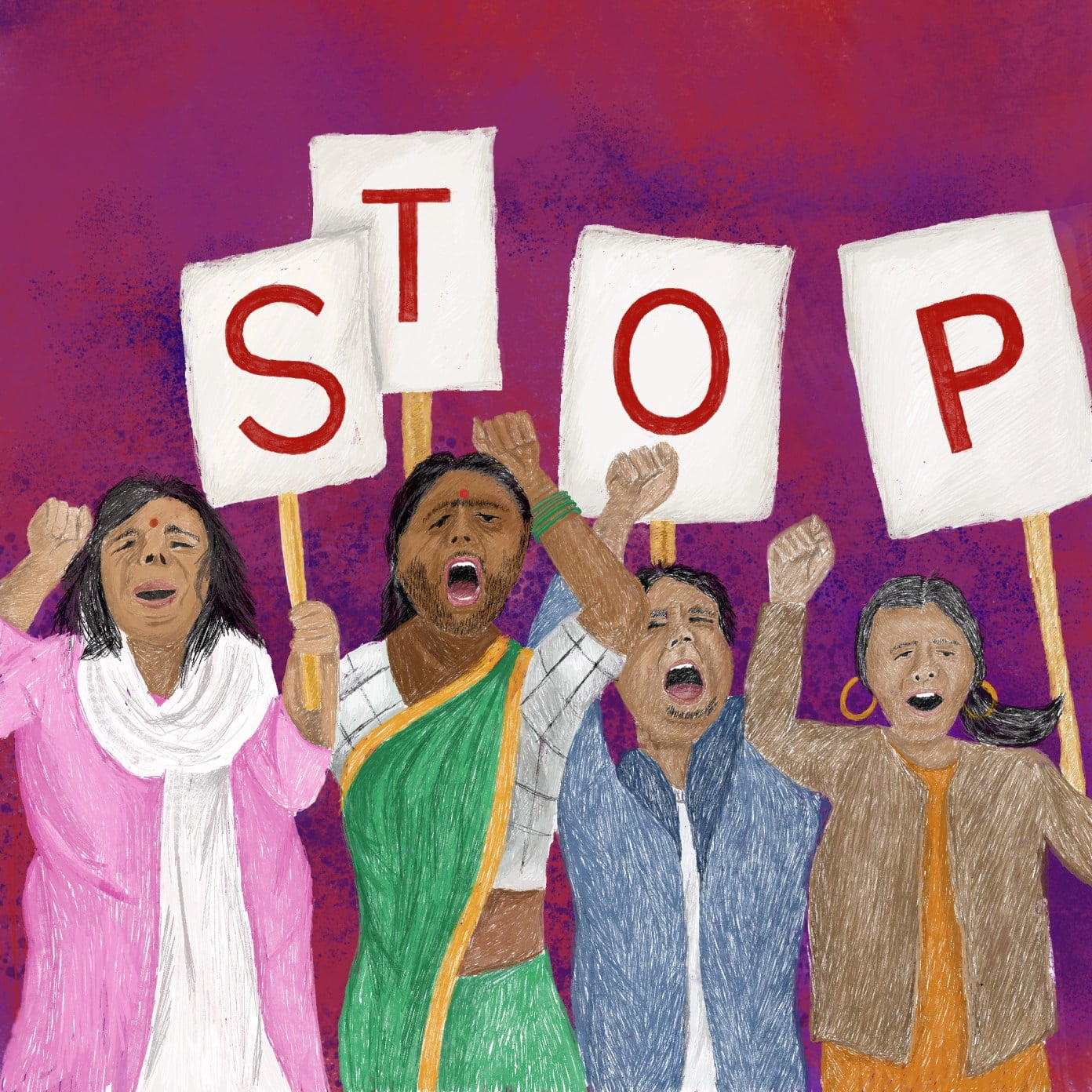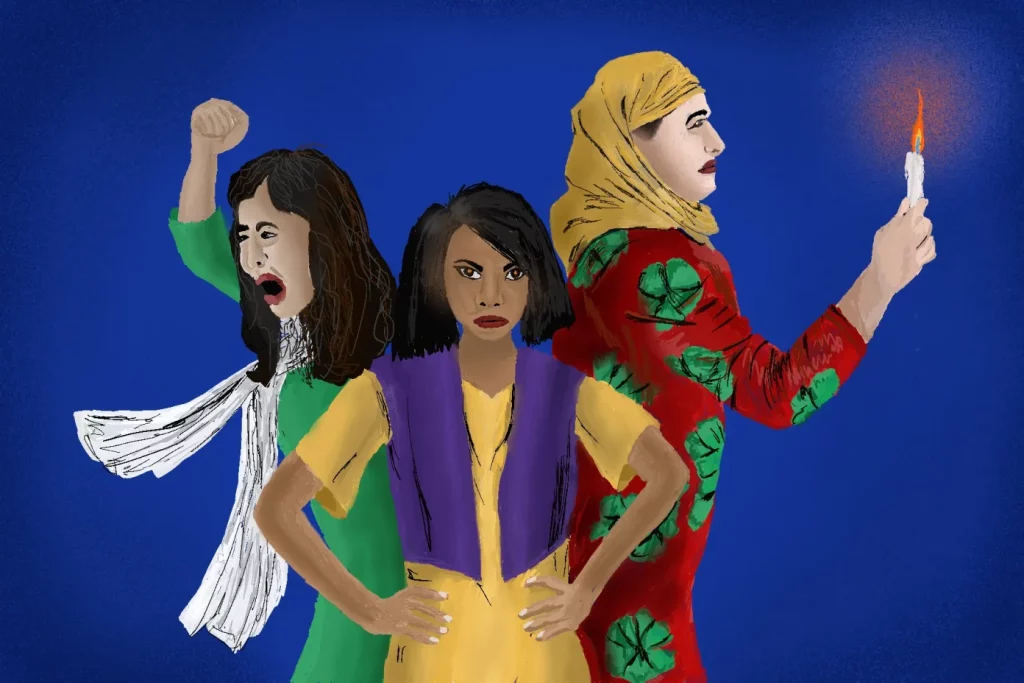We fail victims of sexual violence every day, both socially and institutionally. We subject them to a culture of apathy and scrutiny, where reporting or speaking of sexual violence often leads to victim-blaming, moral policing, social ostracisation, harassment and bullying. These social attitudes then inform institutional and legal approaches; making navigating courts, policing, and the justice system a punishing process that often further traumatises victims by treating them with hostility, suspicion, and callous disregard.
The relentless scrutiny that victims of sexual violence are subjected to presents a catch-22 where reporting violence leads to institutional scrutiny, but failure to report leads to similar social scrutiny. Victims are disbelieved, and the veracity of their accounts are questioned, by the larger public if they don’t report such violence; but if they choose to report, then they encounter institutionalised forms of misogyny and victim-blaming.
The relentless scrutiny that victims of sexual violence are subjected to presents a catch-22 where reporting violence leads to institutional scrutiny, but failure to report leads to similar social scrutiny.
If they are to minimise the extent of such scrutiny, however, women who are victims of sexual violence have to be the perfect victim. Only then do they receive even a modicum of social and institutional support, without their account of horrific abuses being dismissed, disbelieved, trivialised, or normalised. From popular discourse and reportage of sexual violence to court verdicts and policymaking, we are confronted by how public solidarity, justice, and adequate protection of the law are afforded to victims based on the patriarchal myth of the perfect victim.

Reporting on a recent incident of sexual violence in Bengaluru, most media outlets opted to mention in their coverage that the victim was assaulted by a man she sought a ride home from while returning from a party past midnight. The needless mention of the victim’s whereabouts prior to the assault and unnecessary emphasis on the time of day led to predictable victim-blaming and sexist discourse that shifted focus from the perpetrator’s actions to the victim’s, with no dearth of questions about why the victim was outside that late or why she sought a ride from a stranger. This was used to shame the victim, displace responsibility for the crime onto her, and trivialise the violence committed against her by implying the victim brought it upon herself.
Whether explicitly intended to be malicious or not, the majority of the coverage – and discourse – surrounding the crime played into the idea of the perfect victim and made apparent how victims who don’t fit this ludicrous patriarchal narrative are considered deserving of the violence committed against them. While a misogynistic myth, this pervasive narrative possesses massive power insofar as it informs public sentiment and institutional approaches, determining whether victims are deemed deserving of solidarity, support, and justice.
The myth of the perfect victim
Victims finding public solidarity or institutional support is often contingent on how close they come to the definition of the perfect victim. Everything ranging from class and caste location, religion, sexuality, gender identity, why and how much women access public spaces, to what extent they exercise their agency, and if they toe the line of patriarchal boundaries set for them goes into determining this.
A core aspect of whether a victim is deemed to be perfect is their relationship to public spaces. How, when, and why do they occupy or seek to access public spaces and if these reasons align with ideas of legitimacy and respectability is important. This is perhaps best evidenced by the fact that the idea that there are only a few legitimate reasons for women to occupy public spaces at night is so cemented in our culture that it has social and institutional consequences for victims of sexual violence.
According to Professor Jason B Whiting, one of the traits that makes a perfect victim is that they were involved in a respectable activity at the time of victimisation.
According to Professor Jason B Whiting, one of the traits that makes a perfect victim is that they were involved in a respectable activity at the time of victimisation. Which victims receive solidarity is often based on how and why they engage with, negotiate, and seek out public spaces and whether their reasons to even seek such access are considered legitimate or illegitimate within patriarchal frameworks. Who is considered a perfect victim is of course not only limited to this but also to the complex intersection of various, class, caste, religious social identities along with sexual and gender identities; but across identities, issues of legitimate access to public spaces and respectability determine if a victim makes for a perfect victim.

The recent case of sexual violence in Kolkata is in stark contrast to the one in Bengaluru in terms of public sentiment and reportage. Public discourse and reporting of the Kolkata case have been rife with the myth of the perfect victim, with excessive focus on the victim’s profession and her commitment to her work.
In patriarchal societies where women have limited access to public spaces, they have to prove they have a legitimate reason to exist in public. The victim in the Kolkata case fits more closely to the myth of the perfect victim because her claim to public spaces fits patriarchal ideas of legitimacy and respectability, given that it was in the service of others (considering that she is a doctor); whereas the Bengaluru victim’s claim to public spaces is deemed illegitimate because it didn’t fit gendered expectations of respectability.
India is a country where, according to 2018 government data, on average a rape occurs every 15 minutes. A small number of these crimes are reported, a smaller number still receive media attention, and an even tinier fraction leads to any meaningful public outrage or organisation. While it is heartening that the Kolkata rape case has jolted awake a country that has relegated the safety of its women to a mere afterthought by eschewing the realities of rape culture and the violence of patriarchy; we must still ask ourselves why our outrage is only reserved for those victims the patriarchy deems worthy of fighting for.
Victim-blaming and burden-shifting
Most times there is a highly public instance of sexual violence, initial outrage often gives way to what women can do to prevent these crimes: they shouldn’t leave their homes after dark, they must dress modestly, they shouldn’t drink or smoke, they must work respectable jobs, they mustn’t be too friendly but still be agreeable, they mustn’t fraternise with men, and so it goes.
Victim-blaming, benevolent sexism, and shifting the burden for the responsibility of the crime from the perpetrator onto the victim are all quotidian features of sexual violence discourse.
Victim-blaming, benevolent sexism, and shifting the burden for the responsibility of the crime from the perpetrator onto the victim are all quotidian features of sexual violence discourse. A large portion of popular discourse – be that among the general population, key policymakers, the media, or even within institutional settings – parrots tired patriarchal narratives and is chock-full of violently misogynistic attitudes. It serves as a disturbing reminder of the normalisation and trivialisation of sexual violence that rape culture propagates and even the acceptance of it as an inevitability or form of punishment if women transgress sexist boundaries set for them by families and societies.

Twelve years ago, another highly publicised rape case in Kolkata drew very different reactions than the one now. The Park Street rape case saw rabid victim-blaming and institutional apathy because the victim, Suzette Jordan, wasn’t the perfect victim. Jordan was a single mother of two, who was at a nightclub before the assault occurred and accepted a ride home from a group of men who had made her acquaintance there.
Jordan being divorced, visiting a nightclub, and interacting with men were all used to blame her for the assault. She had to move homes due to the incessant harassment and was denied entry at a restaurant following the incident because she was ‘that Park Street rape victim.‘ She not only faced victim-blaming, scrutiny, and harassment by the public, but she also faced institutional forms of it.
West Bengal Chief Minister Mamta Banerjee called her a liar and the assault a manufactured incident. A TMC MP suggested Jordan was a sex worker and this was a dispute with a client. When Jordan initially approached the police, they refused to file her complaint, and instead mocked and derided her. A reluctant police only filed her complaint after the case garnered public interest following considerable media coverage. In court, her actions, behaviour, and character were scrutinised.
Following the 2012, Nirbhaya rape case, the victim was chastised for being out late at night by many, including some politicians.
Following the 2012, Nirbhaya rape case, the victim was chastised for being out late at night by many, including some politicians. One of the convicts in the case said he blamed the victim for the assault in a BBC interview. Last week, days after the Kolkata rape case, the Supreme Court overturned a 2023 Kolkata High Court ruling which acquitted a man for statutory rape, while advising adolescent girls to ‘control their sexual urges‘.
Such reactions to sexual violence are not exceptions, but the norm. These misogynistic attitudes, where perpetrators are coddled while victims are scrutinised, show themselves everywhere: in reportage, online and real discourse, police action (or inaction), court verdicts, and policy. The world of harm it does to victims is abominable.
The myth of the perfect victim is also detrimental to the reporting of sexual violence. Because the myth factors into the institutional treatment of victims – their interactions with the police, medical examiners, and courts – if victims think they won’t fit the mould of the perfect victim, they are discouraged from reporting these crimes to protect themselves from being disbelieved and dismissed.

Victims, within patriarchal societies, are only viewed as deserving justice when they fit squarely within patriarchal notions of gendered expectations, legitimacy, and respectability. Victims shouldn’t have to be perfect to find social and institutional support and to seek justice. They shouldn’t have to implore us to see their humanity, defend the legitimacy of their claim to public space, or adhere to sexist ideas of respectability.
Instead of policing women and their actions in the face of sexual violence, it is time we look inward and question why we, as a society, are so devoid of a conscience that we are willing to displace blame onto victims before we are ever ready to hold perpetrators to account or justice.
When our solidarity for victims of sexual violence is contingent on a patriarchal imagination of an ideal victim; we are allowing the systems that subjugate and perpetrate violence against women to be the arbiter of our collective response and reaction to sexual violence. The myth of the perfect victim is not only a gross disservice to victims of sexual violence; it also takes from us, as women, our power for solidarity and concedes it to the structures of our own oppression.
About the author(s)




